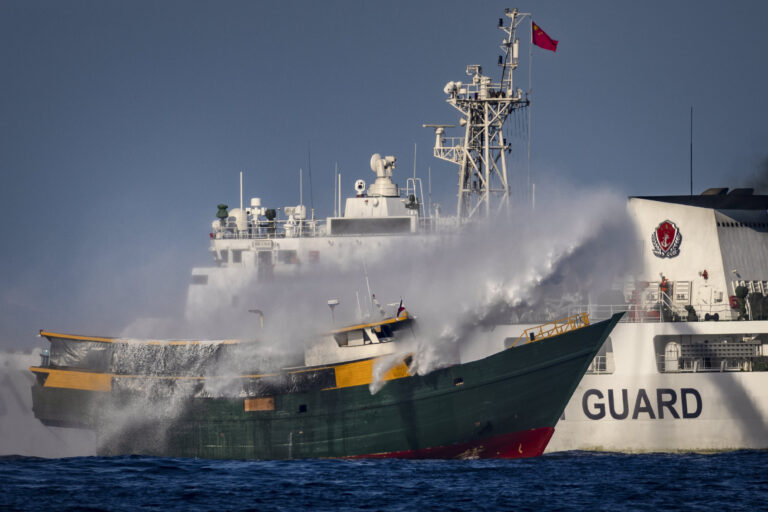Aerial photos show Philippine Navy ships that have been stranded since 1999 to assert the nation’s sovereignty over Second Thomas Shoal, a remote coral reef in the South China Sea that is also claimed by China.
Jay Direct | AFP | Getty Images
The region has seen several clashes over the past few months, and experts say the latest incident marks an increase in tensions and shows the limits of the US-Philippines Mutual Defense Treaty signed in 1951.
“The failure of the MDT to deter [latest confrontation] “This shows the vagueness of the commitments conveyed by both parties,” said Chester Cabarza, president and founder of the International Development and Security Cooperation, a Philippines-based think tank.
Last year, the Philippines and the United States issued new “Bilateral Defense Guidelines,” reaffirming that an “armed attack” on Philippine ships in the South China Sea would trigger U.S. mutual defense obligations.
Meanwhile, China has been careful not to provoke the MDT at Second Thomas Shoal by avoiding the use of firearms and instead employing “gray zone” tactics – coercive actions that fall short of armed conflict – which have reportedly included the use of water cannons and ramming Philippine ships.
Beijing’s actions are aimed at blocking resupply efforts to a rusting Philippine ship that has been stranded on the shoal since 1999, whose presence would appear to lend credibility to the Philippines’ claim to the reef.
Cabarza said Beijing would continue to use “gray zone” tactics to gain control of reefs and other areas disputed by the Philippines unless Manila and Washington made further efforts to increase deterrence.
“The use of these tactics should be classified as an armed attack. [in the MDT] “Whether the U.S. is serious about supporting the Philippines in a strategic and asymmetric war with China,” he said.
GP: Philippine Coast Guard personnel pass a Chinese Coast Guard vessel in a rubber dinghy during a resupply mission to troops stationed at Second Thomas Shoal in the South China Sea, March 5, 2024.
Ezra Acayan | Getty Images News | Getty Images
Richard Heydarian, a policy adviser and senior lecturer in international affairs at the University of the Philippines, said the treaty’s definition of “armed attack” could be broadened to include “intentional acts aimed at causing injury or death to Filipino nationals.”
These guidelines are consistent with the MDT’s interpretation in an unclassified U.S. Indo-Pacific Command report last year.
But Heydarian said the Philippines’ muted response to last week’s clashes could reflect concerns about invoking the mutual defense treaty.
“The Philippine government faces a big dilemma: it wants further reassurances from the United States, which it is unlikely to get, but also wants to avoid an unwanted escalation of tensions,” Heydarian said.
“It is critical that the Philippines and the United States demonstrate that the Philippine military is authorized and authorised to use live ammunition in self-defence and that if China uses live ammunition, a military conflict would ensue immediately,” he added.
But Abdul Rahman Yaacob, a research fellow at the Lowy Institute’s Southeast Asia Program, said the United States is unlikely to expand the scope of the defense pact because doing so could draw the two countries into a broader military conflict.
The Philippines will also consider strengthening its deterrence and strategy in asserting its territorial claims as it “soberly assesses the risks of U.S. non-engagement,” said Matteo Piacentini, a China and Indo-Pacific analyst at Italian think tank Geopolitica.
Philippine President Ferdinand Marcos Jr. said Thursday that the recent incident on the shore was not an “armed attack” but that the country needed to “take action” beyond protesting China’s actions.
On March 5, 2024, in the South China Sea, a China Coast Guard vessel fired a water cannon at the Philippine Navy chartered ship Unaiza May Four, which was on a routine resupply mission to troops stationed at Second Thomas Shoal.
Ezra Acayan | Getty Images News | Getty Images
“The Philippines looks forward to continuing to resupply the Sierra Madre and establishing further bases in its exclusive economic zone in the South China Sea. We have no illusions that China will give up. What Manila is trying to do is not give up itself,” Paisentini said.
The Philippine defense secretary reiterated that the military would not pre-announce resupply missions to the reef, which could allow the Philippines to outmaneuver Beijing while avoiding a direct confrontation, according to the Lowy Institute’s Yaacob.
China is also working to bolster its defenses in the South China Sea with U.S. support.
Geopolitica’s Paisentini said Second Thomas Shoal symbolizes the growing involvement of great powers in Asia’s security architecture, with countries such as the Philippines increasingly turning to the United States and other great powers for deterrence and enhanced security.
“Non-intervention [ if China gets more aggressive] “It will be a major blow not only to U.S.-Philippine relations but also to the U.S.’s relations with other key regional allies,” he added.
From China’s perspective, the reef demonstrates its ability to enforce its claims below the “nine-dash line” and delegitimize rulings from organizations such as the United Nations Convention on the Law of the Sea, which determined in 2016 that Second Thomas Shoal falls under Philippine sovereignty, experts told CNBC.
China also wants to prevent the United States from using the Philippines as a key part of the “First Island Chain,” a chain of islands that includes Japan, Taiwan, the Philippines and parts of Indonesia and is considered strategically important for containing the People’s Liberation Army’s sphere of influence, said researcher Muhammad Faisal.
“All allies and partners will be watching to see how committed the U.S. really is to its military alliances and making plans in case that commitment falters,” added the S. Rajaratnam School of International Studies researcher based in Singapore.

